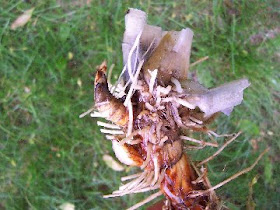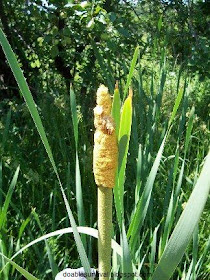If not careful, wild Iris can be mistaken for Cattail. Look for the fluffy Cattail heads left over from last year. There are usually some old ones around.
Like I always say, check several sources and photos before trying a new wild
edible and make sure you have the right plant or just leave it alone.
New growth of Cattails in the spring with some
old fluffy heads from last year.
Spring shoots
Cattail Shoots
In spring, the shoots of the Cattail (new growth) are edible, that is the white base of the shoot. Peel off the outer layer. You can eat them raw or cooked (steamed, boiled, sauteed). I like them. They taste mildly like cucumber and were good on a salad.
In spring, the shoots of the Cattail (new growth) are edible, that is the white base of the shoot. Peel off the outer layer. You can eat them raw or cooked (steamed, boiled, sauteed). I like them. They taste mildly like cucumber and were good on a salad.
Cattail shoots. The white part at the base is edible.
Cattail Flour
You can make flour from the rhizomes. You want to find the base of the stalk with your hand and follow it down to the rhizome and pull hard to get them out or use a shovel. I cheated and used a shovel. ;) Knowing me, I'd pull hard and fly back onto my back in the water. lol I'm a bit of a klutz.
You can make flour from the rhizomes. You want to find the base of the stalk with your hand and follow it down to the rhizome and pull hard to get them out or use a shovel. I cheated and used a shovel. ;) Knowing me, I'd pull hard and fly back onto my back in the water. lol I'm a bit of a klutz.
Anyway, there are different methods to get the starchy white part out to make the flour. One is to break up the rhizomes in a bowl of water and let them sit for a while so that the white starchy part floats to the bottom. Another method is to use a knife to scrape it out. I used a combination of both. I broke them up and let them sit for a while and then scraped them out too and let them sit a bit longer. Apparently, Indians would dry the rhizomes and then pound out the starchy part. You want to take out the fibrous parts. Pour off the excess water and then strain what's left and pick out any fibers left in it. You can use it wet or dry it in the sun, oven (on low), or dehydrator.
I didn't dig a lot. I used the Acorn Bread recipe and substituted 1 cup of the Cattail flour for the Acorn flour. To see the Acorn bread recipes.... (click here)
A Cattail rhizome or at least part of it.
Here's a good sized one after I cleaned it up.
Make sure to to wash out any dirt and mud in there.
The corms are edible, the new growth just coming out on the left
that kind of looks like a claw. Peel them and eat them raw or sauteed.
Shoots and rhizomes.
Rhizomes cleaned and broken up in water.
See the white starchy part on the knife?
Strained. (I have an old cut up T-shirt I like to use.)
I cheated a little and put it in my dehydrator to dry fast,
but you can use it wet too.
I blended it to make it nice and fluffy.
(I didn't try to make a lot this time out.)
Bread dough. (Again for the recipe I used, click on the
link above for the Acorn bread recipe.)
Cattail Acorn Bread
Cattail Flowers
Boil or steam them. I boiled them for 10 minutes. They are good with
butter and salt. The male is the preferred flower, and it comes off more
easily and is more tasty. You can use a fork or knife to carefully take it off. I just pulled it
off the end with my teeth the way you would take a marshmallow off of a stick. The
female flower is harder to get off. I used a small knife to take it off, but many people just eat them like a cob of corn, or "cat on the cob".
This web site gives a recipe for Cattail flower Griddle Cakes. (click here)
These can be eaten raw or cooked. The male and female flowers are actually
together on the same stem. Huh, who knew?! You can see how they are in two segments when they
are green. The top one is the male and will later give off pollen and then
wither away to the small twig you see on to of the Cattails, and the female will turn brown into the "Cattail" everyone is familiar with.
Cooked. (The brown was just from my
handling them, and they had to sit in my car for a
little while.) Male flower on top of the plate
and female flower on the bottom.
Taking it off the stem.
See the difference in texture from the male
flower (left) and female flower (right)?
This web site gives a recipe for Cattail flower Griddle Cakes. (click here)
In this photo, the ones on the right
are turning to pollen.
are turning to pollen.
Cattail Pollen
Harvest
the pollen when the male flower spikes (the top part) have fluffy yellow
pollen. Most instructions say to shake it off in a bag. I just used my fingers to
pull it off into the bag.
Yellow pollen on top. The green below it is the female
part that will turn into the well-known brown spike
later, and the top part withers.
Sift the pollen.
The pollen can be used as a partial flour substitute in breads, cakes,
pancakes, etc. It can also be used as a thickener in things like soups, stews,
etc.
I made some pancakes. I didn't really think they had a distinctive
different taste to them. They just tasted like pancakes to me, but good ones.
It's a great free way to stretch out flour to last longer and a great "survival" food.
Yum!
Here is the recipe I tried:
Cattail Pollen Pancakes
1-1/2 cups flour
1/2 cup cattail pollen
1/4 cup sugar
1 tsp baking soda
1/4 tsp salt
4 eggs
1 cup milk
1/4 cup oil
Just mix and cook like you would regular pancakes.
____________
You can do a search and find different recipes. Here
are a couple recipes from Eat the Weeds: (source link)
Cattail
Pollen Biscuits
The
green bloom spikes turn a bright yellow as they become covered with pollen. Put
a large plastic bag over the head (or tail) and shake. The pollen is very fine,
resembling a curry-colored talc powder. Pancakes, muffins and cookies are
excellent by substituting pollen for the wheat flour in any recipe. Cattail
Pollen Biscuits: Mix a quarter cup of cattail pollen, one and three-quarters cup
of flour, three teaspoons baking powder, one teaspoon salt, four tablespoons
shortening, and three quarters a cup of milk. Bake, after cutting out biscuits,
in 425-degree oven for 20 minutes. For an even more golden tone, you may add an
additional quarter cup of pollen.
Cattail Pollen Pancakes
Mix
one-half cup pollen, one-half cup flour, two tablespoons baking powder, one
teaspoon salt, one egg, one cup of milk, three tablespoon bacon drippings. Pour
into a hot skillet or griddle in dollar, four-inch pancake amounts.
Thanks for checking out my blog. :)
Feel free to leave a comment below.

























I never knew there were two flowers on top of the cattails. Mainly I notice the cattails when they look like cattails... the top is brown or a big fluff top. I guess I better observe them more closely next year. That pancake does look nice around those crispy buttery edges! I see it has lots of eggs and a bit of baking soda instead of baking powder. Hen
ReplyDeleteI didn't know that about cattails before either! The recipe I tried did have a lot of eggs, but there are more "normal" pancake recipes you can try or just substitute some of the pollen for flour in any pancake recipe. :)
ReplyDeleteI was wondering whether I should try pancakes using more eggs and baking soda instead of the traditional recipe. Not that I really need to start liking pancakes, but I do use them for a supper when I don't know what else to have.
ReplyDeleteHee hee... no more robot... you didn't have to do that... :)
ReplyDelete;) I'll just weed out the ads myself. lol
ReplyDeleteI like French toast too.
ReplyDelete